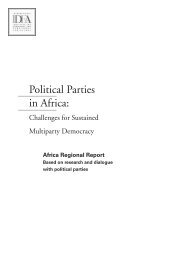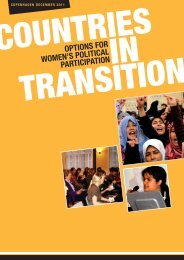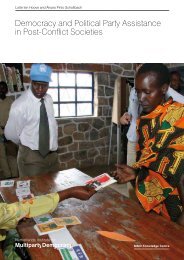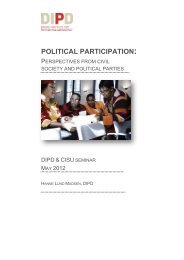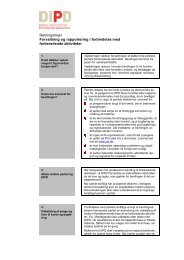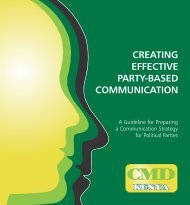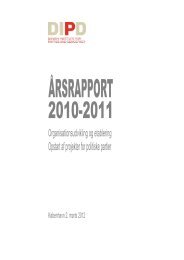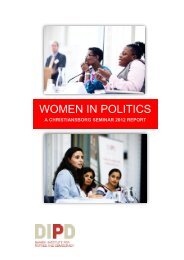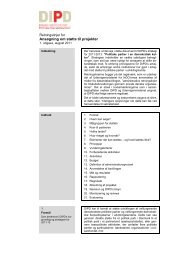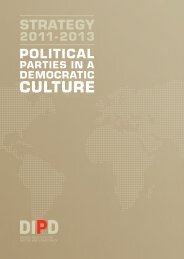Background Document - Danish Institute for Parties and Democracy
Background Document - Danish Institute for Parties and Democracy
Background Document - Danish Institute for Parties and Democracy
You also want an ePaper? Increase the reach of your titles
YUMPU automatically turns print PDFs into web optimized ePapers that Google loves.
y American, French, German, <strong>and</strong> British women, who developed both theory <strong>and</strong><br />
practice through close contacts maintained through travel, letters, <strong>and</strong> exchange of<br />
literature. Against the backdrop of the 1848 revolutions, the world’s first women’s<br />
rights convention, in Seneca Falls, USA, adopted a manifesto entitled the Declaration<br />
of Sentiments, which called <strong>for</strong> full implementation of equal rights.<br />
THE STRUGGLE FOR WOMEN’S SUFFRAGE<br />
The late fall of absolute monarchy in Denmark meant that feminism had already<br />
found a definite <strong>for</strong>m when the Constitutional Assembly convened. It was thus an act<br />
of bad faith when the <strong>Danish</strong> founding fathers, who were well-in<strong>for</strong>med of international<br />
developments, inducted the <strong>Danish</strong> Constitutional Act of June 5th, 1849 into the<br />
man’s rights tradition based on the infamous – <strong>and</strong> erroneous – statement that “it is<br />
thus everywhere recognised that persons of incompetence, children, women, criminals<br />
shall not be eligible to vote.”<br />
Hardly had the ink of the Constitutional Act dried be<strong>for</strong>e the men of the new democracy<br />
admitted that they had set aside women’s human rights. As early as in 1857,<br />
Parliament passed a collection of equal rights laws as part of a major re<strong>for</strong>m programme<br />
with the goal of making women full citizens. The first concern was making<br />
unmarried women legally competent, independent citizens.<br />
This was because the pre-modern marriage code, with its autocratic paterfamilias,<br />
stymied the rights of married women. In the article “Three Questions about Womanhood<br />
Suffrage”, political scientist Carole Pateman reflects on the differences between<br />
women’s <strong>and</strong> other social groups’ struggles <strong>for</strong> political rights. Why did suffragettes in<br />
Britain <strong>and</strong> the United States have to fight <strong>for</strong> half a century <strong>for</strong> the right to vote? How<br />
could dem<strong>and</strong>s <strong>for</strong> voting rights in Western democracies around the year 1900 lead to<br />
assassinations <strong>and</strong> suicides, mass arrests, hunger strikes, <strong>and</strong> <strong>for</strong>ced feeding?<br />
Her answer is that the man’s status as head of the family was regarded as the last<br />
bastion of patriarchy. Voting rights was not a question of the women’s cause in general;<br />
it was a matter specifically of the position of the married woman. “[S]uffrage was,<br />
at bottom, the wife question, not a woman’s question” 4 .<br />
<strong>Danish</strong> equal rights policy between 1849 <strong>and</strong> 1915 falls into two stages. The most<br />
obvious marker of the watershed is the ascent of the women’s movement in 1871 with<br />
the <strong>for</strong>mation of the feminist mother organisation <strong>Danish</strong> Women’s Society.<br />
In the first phase, the initiative was in the h<strong>and</strong>s of Parliament, who constructed<br />
the female citizen in the image of the paterfamilias by according civilian <strong>and</strong> social<br />
rights to unmarried female heads of household. The second phase is characterised by<br />
a close alliance between the women’s movement <strong>and</strong> the increasingly successful political<br />
left, whose agenda was the extension of democratic rights to all, regardless of<br />
gender, social class, <strong>and</strong> civil status.<br />
In other words, the women’s cause was integrated into the general de-m<strong>and</strong> <strong>for</strong><br />
democratisation, <strong>and</strong> the struggles <strong>for</strong> equal <strong>and</strong> universal suffrage <strong>and</strong> against patriarchal<br />
marriage could be synthesised in the assault on the privileged paterfamilias.<br />
The chief architects behind the new equal status strategy were the husb<strong>and</strong> <strong>and</strong><br />
wife couple Fredrik <strong>and</strong> Mathilde Bajer. They drew their inspiration from the international<br />
women’s movement, <strong>and</strong> specifically from the British power couple Harriet<br />
4 Pateman 1994, p. 336.<br />
“From the outset, men participated<br />
in the struggle <strong>for</strong> equal status.”<br />
WOMEN IN POLITICS DANISH INSTITUTE FOR PARTIES AND DEMOCRACY PAGE 49



